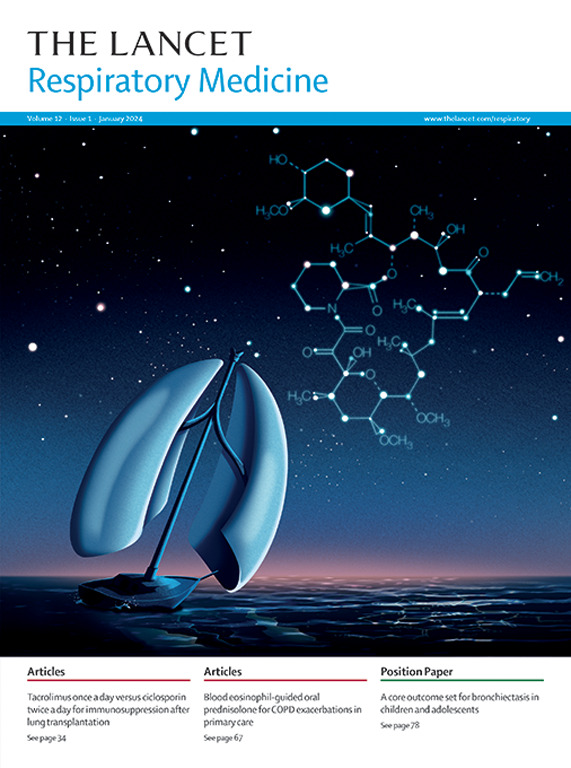奈替达尼治疗淋巴管瘤病患者:一项开放标签、单臂的2期研究
IF 38.7
1区 医学
Q1 CRITICAL CARE MEDICINE
引用次数: 0
摘要
背景淋巴管瘤病是一种非常罕见的疾病,主要影响育龄妇女。MILES 试验表明,mTOR 抑制剂西罗莫司能有效稳定淋巴管瘤病患者的肺功能。药物毒性和耐药性的产生是西罗莫司治疗的潜在局限性。Nintedanib是一种抑制PDGFR的多激酶抑制剂,在人类和鼠类淋巴管瘤病病变中具有活性。我们旨在研究宁替达尼在淋巴管瘤病患者中的活性和安全性。方法这项 2 期、开放标签、单臂研究在意大利米兰的全国罕见肺病大学转诊中心 MultiMedica IRCCS 进行。符合条件的参与者年龄在18岁及以上,患有散发性或结节性硬化症复合体相关淋巴管瘤病,且在过去一年中尽管接受了西罗莫司治疗但肺功能仍在进行性下降,或者尚未接受治疗。患者口服宁替达尼150毫克,每天两次,持续12个月,如果出现副作用或肝毒性,可减量至100毫克,每天两次,之后12个月不进行研究治疗。主要终点是 12 个月内 FEV1 的变化(以升为单位的 FEV1 斜率)。本研究已在 ClinicalTrials.gov 注册,编号为 NCT03062943。研究结果从 2016 年 10 月 14 日至 2019 年 12 月 13 日,35 名女性患者(平均年龄 50 岁 [SD 11])进入研究,其中 30 人符合条件并接受了宁替尼治疗。12 个月后,22 名患者完成了治疗,其中 19 人还完成了 12 个月的随访。治疗一年后,FEV1保持稳定(预测平均差值为0-001 L [95% CI -0-063 to 0-066]; p=0-97)。在停止治疗的 12 个月期间,观察到 FEV1 略有下降(预测平均差值为 -0-076 L [95% CI -0-149 至 -0-004];P=0-040)。最常见的不良反应是恶心(15 名患者 [50%])、腹泻(8 名患者 [26%])和腹痛(2 名患者 [7%])。我们的研究结果表明,宁替尼未改善 FEV1,但治疗耐受性总体良好。这些结果可能支持将宁替尼作为mTOR抑制剂标准治疗无效患者的二线疗法。进一步的研究,如比较宁替达尼和西罗莫司的非劣效性试验,将有助于更好地阐明这种药物作为潜在替代疗法的作用。本文章由计算机程序翻译,如有差异,请以英文原文为准。
Nintedanib for patients with lymphangioleiomyomatosis: a phase 2, open-label, single-arm study
Background
Lymphangioleiomyomatosis is an ultra-rare disease mainly affecting women of childbearing age. The MILES trial showed the efficacy of sirolimus, an mTOR inhibitor, in stabilising lung function in patients with lymphangioleiomyomatosis. Drug toxicity and development of resistance are potential limitations of therapy with sirolimus. Nintedanib is a multikinase inhibitor that inhibits PDGFR, which is active in human and murine lymphangioleiomyomatosis lesions. We aimed to investigate the activity and safety of nintedanib in patients with lymphangioleiomyomatosis.Methods
This phase 2, open-label, single-arm study was conducted at MultiMedica IRCCS, a national referral university centre for rare pulmonary diseases in Milan, Italy. Eligible participants were aged 18 years and older and had sporadic or tuberous sclerosis complex-associated lymphangioleiomyomatosis with progressive pulmonary function decline in the past year despite treatment with sirolimus or treatment naive. Patients received nintedanib 150 mg orally twice per day, with a possible reduction to 100 mg twice per day in case of side-effects or hepatoxicity, for 12 months, followed by a period of 12 additional months without study treatment. The primary endpoint was the change in FEV1 (FEV1 slope in L) over 12 months. This study is registered with ClinicalTrials.gov, NCT03062943.Findings
From Oct 14, 2016, to Dec 13, 2019, 35 female patients (mean age 50 years [SD 11]) entered the study, 30 of whom were eligible and received nintedanib. After 12 months, 22 patients completed the treatment, 19 of whom also completed the 12 months of follow-up. FEV1 remained stable after one year of treatment (predicted mean difference 0·001 L [95% CI –0·063 to 0·066]; p=0·97). During the 12 months off treatment, a slight decline in FEV1 was observed (predicted mean difference –0·076 L [95% CI –0·149 to –0·004]; p=0·040). The most frequent adverse events were nausea (15 [50%] patients), diarrhoea (eight [26%]), and abdominal pain (two [7%]). No serious adverse events were observed during the treatment period.Interpretation
Our findings suggest that nintedanib did not improve FEV1, but that the treatment was generally well tolerated. These results might support nintedanib as a second-line therapy in patients not controlled by standard treatment with mTOR inhibitors. Further investigation, such as a non-inferiority trial comparing nintedanib and sirolimus could help to better clarify the role of this drug as a potential alternative treatment.Funding
Boehringer-Ingelheim.求助全文
通过发布文献求助,成功后即可免费获取论文全文。
去求助
来源期刊

Lancet Respiratory Medicine
RESPIRATORY SYSTEM-RESPIRATORY SYSTEM
CiteScore
87.10
自引率
0.70%
发文量
572
期刊介绍:
The Lancet Respiratory Medicine is a renowned journal specializing in respiratory medicine and critical care. Our publication features original research that aims to advocate for change or shed light on clinical practices in the field. Additionally, we provide informative reviews on various topics related to respiratory medicine and critical care, ensuring a comprehensive coverage of the subject.
The journal covers a wide range of topics including but not limited to asthma, acute respiratory distress syndrome (ARDS), chronic obstructive pulmonary disease (COPD), tobacco control, intensive care medicine, lung cancer, cystic fibrosis, pneumonia, sarcoidosis, sepsis, mesothelioma, sleep medicine, thoracic and reconstructive surgery, tuberculosis, palliative medicine, influenza, pulmonary hypertension, pulmonary vascular disease, and respiratory infections. By encompassing such a broad spectrum of subjects, we strive to address the diverse needs and interests of our readership.
 求助内容:
求助内容: 应助结果提醒方式:
应助结果提醒方式:


